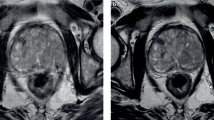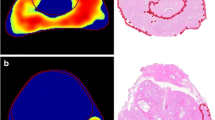Abstract
Purpose
To evaluate a 12-month long-distance prostate MRI quality assurance (QA) program.
Methods
The need for IRB approval was waived for this prospective longitudinal QA effort. One academic institution experienced with prostate MRI [~ 1000 examinations/year (Site 2)] partnered with a private institution 240 miles away that was starting a new prostate MRI program (Site 1). Site 1 performed all examinations (N = 249). Four radiologists at Site 1 created finalized reports, then sent images and reports to Site 2 for review on a rolling basis. One radiologist at Site 2 reviewed findings and exam quality and discussed results by phone (~ 2–10 minutes/MRI). In months 1–6 all examinations were reviewed. In months 7–12 only PI-RADS ≤ 2 and ‘difficult’ cases were reviewed. Repeatability was assessed with intra-class correlation (ICC). ‘Clinically significant cancer’ was Gleason ≥ 7.
Results
Image quality significantly (p < 0.001) improved after the first three months. Inter-rater agreement also improved in months 3–4 [ICC: 0.849 (95% CI 0.744–0.913)] and 5–6 [ICC: 0.768 (95% CI 0.619–0.864)] compared to months 1–2 [ICC: 0.621 (95% CI 0.436–0.756)]. PI-RADS ≤ 2 examinations were reclassified PI-RADS ≥ 3 in 19% (30/162); of these, 23 had post-MRI histology and 57% (13/23) had clinically significant cancer (5.2% of 249). False-negative examinations [N = 18 (PI-RADS ≤ 2 and Gleason ≥ 7)] were more common at Site 1 during months 1–6 [9% (14/160) vs. 4% (4/89)]. Positive predictive values for PI-RADS ≥ 3 were similar.
Conclusion
Remote quality assurance of prostate MRI is feasible and useful, enabling new programs to gain durable skills with minimal risk to patients.




Similar content being viewed by others
References
Weinreb JC, Barentsz JO, Choyke PL, et al. (2016) PI-RADS prostate imaging-reporting and data system: 2015, version 2. Eur Urol 69:16–40
Vargas HA, Hotker AM, Goldman DA, et al. (2016) Updated prostate imaging reporting and data system (PIRADS v2) recommendations for the detection of clinically significant prostate cancer using multiparametric MRI: critical evaluation using whole-mount pathology as standard of reference. Eur Radiol 26:1606–1612
Siddiqui MM, Rais-Bahrami S, Turkbey B, et al. (2015) Comparison of MR/ultrasound fusion-guided biopsy with ultrasound-guided biopsy for the diagnosis of prostate cancer. JAMA 13:390–397
Rosenkrantz AB, Ginocchio LA, Cornfeld D, et al. (2016) Interobserver reproducibility of the PI-RADS version 2 lexicon: a multicenter study of six experienced prostate radiologists. Radiology 280:793–804
Gaziev G, Wadhwa K, Barrett T, et al. (2016) Defining the learning curve for multiparametric magnetic resonance imaging (MRI) of the prostate using MRI-transrectal ultrasonography (TRUS) fusion-guided transperineal prostate biopsies as a validation tool. BJU Int 117:80–86
Rosenkrantz AB, Ayoola A, Hoffman D, et al. (2017) The learning curve in prostate MRI interpretation: self-directed learning versus continual reader feedback. AJR Am J Roentgenol 208:W92–W100
Harris RD, Schned AR, Heaney JA (1995) Staging of prostate cancer with endorectal MR imaging: iessons from a learning curve. RadioGraphics 15:813–829
Akin O, Riedl CC, Ishill NM, et al. (2010) Interactive dedicated training curriculum improves accuracy in the interpretation of MR imaging of prostate cancer. Eur Radiol 20:995–1002
Latchamsetty KC, Borden LS Jr, Porter CR, et al. (2007) Experience improves staging accuracy of endorectal magnetic resonance imaging in prostate cancer: what is the learning curve? Can J Urol 14:3429–3434
Garcia-Reyes K, Passoni NM, Palmeri ML, et al. (2015) Detection of prostate cancer with multiparametric MRI (mpMRI): effect of dedicated reader education on accuracy and confidence of index and anterior cancer diagnosis. Abdom Imaging 40:134–142
Mager R, Brandt MP, Borgmann H, et al. (2017) From novice to expert: analyzing the learning curve for MRI-transrectal ultrasonography fusion-guided transrectal prostate biopsy. Int Urol Nephrol. https://doi.org/10.1007/s11255-017-1642-7
Kierans AS, Taneja SS, Rosenkrantz AB (2015) Implementation of multi-parametric prostate MRI in clinical practice. Curr Urol Rep 16:56
Leake JL, Hardman R, Ojili V, et al. (2014) Prostate MRI: access to and current practice of prostate MRI in the United States. J Am Coll Radiol 11:156–160
Muthigi A, Sidana A, George AK, et al. (2017) Current beliefs and practice patterns among urologists regarding prostate magnetic resonance imaging and magnetic resonance-targeted biopsy. Urol Oncol 35:32.e1–32.37.
Alpert HR, Hillman BJ (2004) Quality and variability in diagnostic radiology. J Am Coll Radiol 1:127–132
Mungovan SF, Sandhu JS, Akin O, et al. (2007) Preoperative membranous urethra length measurement and continence recovery following radical prostatectomy: a systematic review and meta-analysis. Eur Urol 71(3):368–378
Rosenkrantz AB, Shanbhoque AK, Wang A, et al. (2016) Length of capsular contact for diagnosing extraprostatic extension on prostate MRI: assessment at an optimal threshold. J Magn Reson Imaging 43:990–997
Viera AJ, Garrett JM (2005) Understanding interobserver agreement: the kappa statistic. Fam Med 37:360–363
Hallgren KA (2012) Computing inter-rater reliability for observational data: an overview and tutorial. Tutor Quant Methods Psychol 8:23–34
Author information
Authors and Affiliations
Corresponding author
Ethics declarations
Funding
No extramural funding solicited or used for this work.
Disclosures
Matt Davenport—Royalties from Wolters Kluwer. All other authors—No relevant financial disclosures.
Ethical approval
This prospective longitudinal quality assurance effort was considered to be exempt from oversight by the host institutional review board (IRB). No extramural funding was used. All procedures performed in studies involving human participants were in accordance with the ethical standards of the institutional and/or national research committee and with the 1964 Helsinki declaration and its later amendments or comparable ethical standards.
Rights and permissions
About this article
Cite this article
Curci, N.E., Gartland, P., Shankar, P.R. et al. Long-distance longitudinal prostate MRI quality assurance: from startup to 12 months. Abdom Radiol 43, 2505–2512 (2018). https://doi.org/10.1007/s00261-018-1481-8
Published:
Issue Date:
DOI: https://doi.org/10.1007/s00261-018-1481-8




